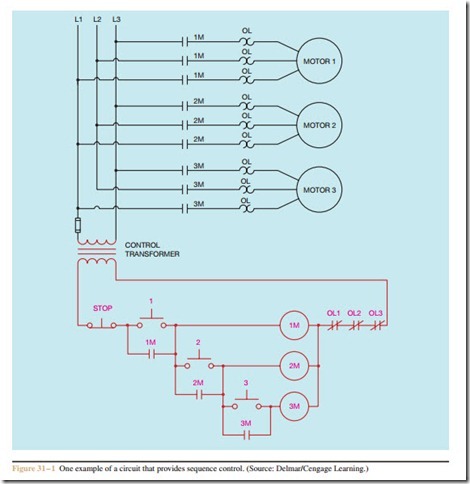Sequence control forces motors to start or stop in a pre- determined order. One motor cannot start until some other motor is in operation. Sequence control is used by such machines as hydraulic presses that must have a high pressure pump operating before it can be used, or by some air conditioning systems that require that the blower be in operation before the compressor starts. There are several methods by which sequence control can be achieved.
Sequence Control Circuit #1
One design that will meet the requirements is shown in Figure 31 – 1. In this circuit, push button #1 must be pressed before power can be provided to push but- ton #2. When motor starter #1 energizes, the normally open auxiliary contact 1M closes, providing power to coil 1M and to push button #2. Motor starter #2 can now be started by pressing push button #2. Once motor starter #2 is energized, auxiliary contact 2M closes, providing power to coil 2M and push button #3. If the stop button should be pressed or if any overload contact opens, power will be interrupted to all starters.
Sequence Control Circuit #2
A second method of providing sequence control is shown in Figure 31 – 2. Since the motor connections are the same as the previous circuit, only the control part of the schematic is shown. In this circuit, normally open auxiliary contacts located on motor starters 1M and 2M are used to ensure that the three motors start in the proper sequence. A normally open 1M auxiliary contact connected in series with starter coil 2M prevents motor #2 from starting before motor #1, and a normally open 2M auxiliary contact connected in series with coil 3M prevents motor #3 from starting be- fore motor #2. If the stop button should be pressed or if
any overload contact should open, power will be inter- rupted to all starters.
Related posts:
Incoming search terms:
- sequence starter circuit diagram
- sequence motor control circuit
- sequence control circuit
- sequence starters
- sequence starter
- Sequence motor
- electrical sequence control
- sequence starter control circuit
- sequence starting motors
- sequence controls for motor starters
- motor sequence start circuits
- sequence motor control
- sequence starter motor
- electrical sequences
- sequence control of three phase installation design
- sequence starter drawings
- sequential start stop circuitd
- motor 1 must start before motor 2
- start and stop motor sequence diagram pdf
- sequence starter circuits
- sequence of starting of motor
- best way to understand sequence starters
- sequence starter motor control circuit
- notes about how to connect 2 motors in sequential
- sequential starting of three motors
- sequence control
- sequence operation of two motors
- starting sequence for the motor
- line diagram showing the sequence of control in a domestic premise from the intake point to the final circuits
- application of sequential motor
- sequential starter
- automatic sequential motor control
- importance of sequential starting of a motor
- sequencial motor control
- sequence 2 motor starters
- Sequence motor starter
- best way to understand starter circuits and controls
- electrical engineering sequence starter motor pdf
- direct online main circuit
- Basic circuits of sequence control
- drow squantial moter control
- auto sequence start power circuit
- sequence register control circuit
- Make a labelled diagram of the sequence of control for domestic premise
- power on/off sequence circuit
- describe the principle operation of pump down wiring circuit
- sequence motor starting
- PH1 - Complete the Sequential Control Circuit to the required standards
- sequence starting of two motors
- sequence control circuits
